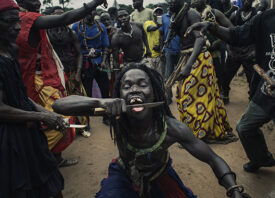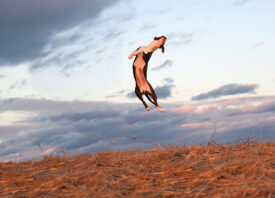Search this site
From Senegal To The Amazon, A Photographer Explores Mankind’s Relationship with Nature

“The common thread that runs through all my stories is my interest in humankind in relation to the environment–even at its most extreme, raw, and ruthless,” the photojournalist Diana Bagnoli tells me. Four years ago, she was named a winner of the Feature Shoot Emerging Photography Awards for her documentation of the Boukout, an initiation rite for young men from Senegal’s Jola community, taking place in a holy forest. Since then, she’s continued to tell stories about people and their relationship to the Earth, from villages in the Amazon to the Atlantic coast of France and far beyond.
In recent years, Bagnoli has photographed the use of medical herbs among the Raramuri people in the village of Munerachi, Chihuahua, Mexico. She’s traveled to the Rasuwa district in Nepal to meet the people affected by landslides made worse by deforestation, and she’s joined the Sea Shepherds in their efforts to protect dolphins from being killed as part of massive fishing operations. In traveling the world, the photojournalist has seen devastation and hope in equal measure. Ahead of the September 3rd deadline for this year’s Emerging Photography Awards, we had the chance to catch up and learn more about her work over the last four years.

You won the Emerging Photography Awards in 2017 for your project on the Boukout, a month-long initiation for young men in the village of Mlomb in Casamance, Senegal. What is one of your most powerful memories from your time with this community, even years later?
“I still remember vividly the energy and expressive power of the Jolà people in Casamance. Being able to share the celebrations for the initiation rite with them was a priceless experience. I remember, in particular, the kindness with which I was welcomed during that month, as if I were one of the family. I absolutely owe this to my fixer and friend Demba Mane. Since then, we have kept in touch and regularly update each other on our lives.
“I was hosted in his family home in the countryside in Mlomb. The house was full because of the Boukout; several adults and children had come to share the big event. So they put me to sleep in his older sister’s bed, who kindly shared her mattress on the floor with me. The mosquito net protected us from insects, and the chickens walked around the room. Once, I woke up with two fresh eggs hatched at my feet.
“That journey was complicated because I suffered from a high fever and migraine. I still fondly remember how I was looked after. The girl who changed the wet patches on my forehead said to me in French, ‘à partir de maintenant tu es ma soeur,’ from now on you are my sister. So I can say, without any doubt, that the most powerful memory is the affection I received from Demba’s family and his wife, as well as the whole village.”

What are some of your proudest moments from the years since you won the award?
“The Emerging Photography Awards enhanced my work and helped me get more prestigious jobs. Since then, I have also won other awards and honorable mentions, and my pictures have been seen around the world. I’ve just won the 2nd Place at the International Photo Award, for the ‘Our Times’ competition, with a shot of an elder man in a retirement home who hugs his daughter through an inflatable structure.
“One of the latest and most significant awards has been receiving the National Geographic Society’s Emergency Fund for Journalists to cover a COVID story. It will also be part of Inside the Curve, a traveling exhibition produced by National Geographic. The story I have documented is about the Henry Reeve Brigade, a group of 36 Cuban doctors, epidemiologists, and nurses who came to Northern Italy at the beginning of the pandemic to help us heal COVID patients.”

You’ve documented several stories related to the COVID crisis. What has it been like for you emotionally to cover the pandemic?
“The story of the Cuban doctors was memorable, as they gave a strong example of solidarity: a third world country sent humanitarian aid to the worst place for the pandemic at that time, when nothing was yet was known. Thanks to National Geographic’s Emergency Fund for Journalists, I’ve been able to document their work for two months in a temporary COVID hospital. Their work ended with the honorary citizenship of the brigade leader and a brotherhood with Cuba that we must not forget right now–now that they are the ones who need it.
“COVID’s first year came as a shock to everyone. I documented first the COVID burials in my city cemetery, where there was a sad overload of activity. Then, I documented childbirth during the pandemic, as the Rava Foundation donated medical facilities to allow pregnant women affected by COVID-19 to safely give birth. Going from death to life has been a very strong emotion; if I entered into the hospital frightened, I came out somehow thrilled. Seeing babies being born in that context of protective suits, security protocols, and maximum alert filled my heart with joy and hope. This is when I realized that life is always going to be stronger.”

Would you say that there’s a through-line connecting all of your work as a photojournalist?
“The Boukout story was part of a long-term project that lasted five years on mysticism in different parts of the world. The curiosity to understand the mysteries, beliefs, and answers that very different populations gave themselves led me to travel to the peaks of the Andes, into the Amazon, as well as to Haiti to visit the voodoo priests. The trust and connection that these ancient cultures still have for the nature that surrounds them has taught me a lot.”
Learn more about the Feature Shoot Emerging Photography Awards, including how to submit your work, by visiting our website.



